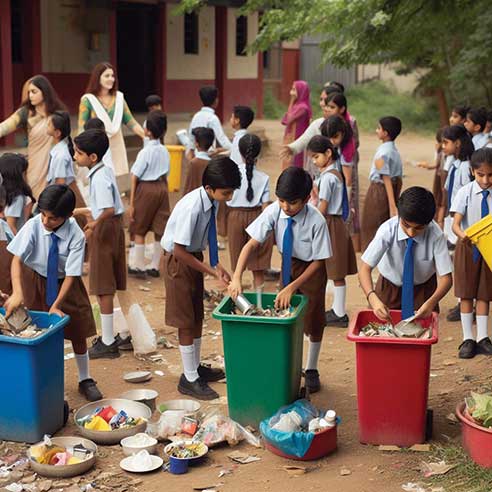Sushmita Aripirala
Early years
I still fondly remember my kindergarten school days – the vast open ground with a pottery wheel, the school bell signalling the start of our adventures, the autos lined up outside waiting to whisk us away, and of course, my beloved teacher, Lakshmi ma’am, who taught us not just the alphabet but also the joy of learning. Those were the days filled with innocence and wonder.
Life takes us on unplanned journeys and my father’s job led to my being a part of a different school in class one. This school, located in a residential colony, provided a unique experience. It played a pivotal role in my journey of understanding the profound impact schools can have on our communities.
In this new school, we the children, became active participants in the community activities. These activities were not confined to the school’s premises but extended to the neighbourhood. We cleaned up the local park, segregated waste and tamed the unruly grass at the common playground. I didn’t initially grasp the significance of these activities but joined in simply because my friends did. These initiatives instilled in us a sense of responsibility toward our surroundings and the people we shared them with. It was a transformative experience that sowed the seeds of community engagement and made me realize the power of schools in shaping neighbourhoods.
Seven years passed in that school, and then I moved to another school. This was nestled close to a busy main road. I no longer had a playground within the school premises. Instead, I faced daily traffic jams. I watched our auto driver engage in endless altercations and insults with fellow travellers. Over time, the traffic conditions worsened, especially during the monsoons. But the school seemed detached from these issues – its primary focus appeared to be academic scores. I couldn’t help but miss my old school, its camaraderie, and the community-building activities that once united us.

Getting back with schools
Life moved on and I completed my university education. A few years into my work life, I began volunteering with NGOs. It was here that I was reintroduced to the realm of schools. As I joined hands with these NGOs, my perception of schools evolved. It struck me that schools are not merely institutions of learning but integral parts of our communities. These NGOs, specializing in education and community development, opened my eyes to the significant role that schools can play in shaping neighbourhoods. They are a conduit through which impactful changes can be achieved. It was in this context that I realized that not just any school, but every school, can become a linchpin for positive transformation. Schools could bridge the gap between education and community development, and they were uniquely positioned to create impactful changes.
With this newfound purpose, I embarked on a journey of collaboration with local schools and NGOs. Together, we ventured beyond traditional educational practices to nurture students as well-rounded individuals who understood their responsibilities within the community.

One of our primary areas of focus was waste management. We recognized that schools, by managing their own waste, could set an example for students and the community at large. This wasn’t limited to waste generated within the school but extended to the neighbourhood. Teachers, students and other staff at the schools actively discussed waste management with the local community. They sought the community’s insights and cooperation.
In residential areas where schools had substantial campuses, waste management became a comprehensive effort. The local authorities, who were critical partners in executing these initiatives, were actively involved. We held constructive dialogues with local authorities, which included municipal corporations and panchayats, to secure their support. We emphasized the importance of these programs for both students and the entire community. Through community awareness programs, we sought to enlighten residents about the far-reaching benefits of these initiatives.
As a result of our combined efforts, schools began actively participating in waste management. They established systems to segregate and recycle waste within their premises. Students were not only taught about recycling and responsible waste disposal; they were actively involved in implementing these practices. The impact extended beyond the school walls, influencing the neighbourhood.
Traffic management was another area we worked on. Here schools played a pivotal role in raising awareness. They organized campaigns, in which students, their families, and the local authorities participated. Families were encouraged to adopt carpooling, use public transport, or join walking school buses (groups of children walking to school with one or more adults), while local authorities tried facilitating safe school zones. Volunteers, including parents and teachers, played a crucial role in managing traffic during peak hours. These collaborative efforts aimed to reduce traffic congestion, make school zones safer and the neighbourhoods more pleasant to live in.

The impact of these initiatives created ripples through the communities. Cleaner neighbourhoods led to healthier living environments. Reduced traffic congestion meant fewer frayed nerves during rush hours, and the students not only excelled academically but also imbibed essential life skills, such as environmental responsibility and civic participation.
Understanding today
Today, schools are no longer just buildings within our neighbourhoods. They are dynamic hubs that can bring in positive change in communities. Schools unite residents in shared missions of development, foster collaboration, and enhance the overall quality of life. They should view themselves as active participants in the development of their communities, giving back and imparting vital lessons in social responsibility to their students.
In conclusion, the journey from a kindergarten playground to advocating for school-community collaboration has opened my eyes to the profound potential that schools hold. They can serve as more than just educational institutions; they can become transformative forces within communities. It’s time for schools to embrace their roles as not just places of learning but as community anchors, nurturing growth, and building stronger, more vibrant neighbours.
The author has moved on from working as a senior system architect to a passionate advocate for educational and social initiatives. Today, she wholeheartedly engages with low-income private schools and government institutions, championing equitable education and community development. She can be reached at sushmita.aripirala@gmail.com.
